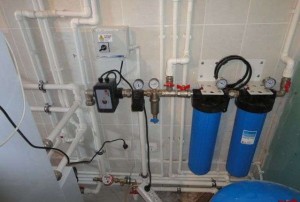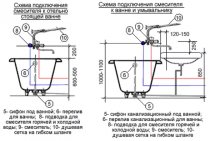The pumping station is connected with the following materials and equipment
- the pumping station itself;
- American women;
- fittings;
- tees;
- oblique filter;
- cut-offs;
- ball valves;
- check valve.
The number of elements when connecting a residential building depends on the required number of outlets. The center of the water supply system is the pumping station. It is simultaneously connected to pipes leading to a water source, and to intra-house communications.
Sewer elements
As noted earlier, water supply and sanitation cannot be fully utilized without each other. The construction of a drainage system in a private house is based on one of the mandatory elements: a septic tank or a biological treatment plant.
An autonomous sewer system in its structure has a partial resemblance to a water supply system. The main difference is that the elements of this system are not three, but two: a pipeline and a treatment plant.
The most important moment in the organization of wastewater disposal is the choice of the type of treatment plant. Modern methods of organizing such systems offer a choice of many options:
- a cesspool or a storage tank are outdated options that involve regular significant maintenance and cleaning costs using the services of professional vacuum cleaners who pump out and dispose of accumulated wastewater. Another significant drawback is the unpleasant odor caused by the decomposition of the wastewater content. This deficiency is especially pronounced in the warm season.
- septic tank or biological station - modern options that allow you to purify water within the sewer system to a state that makes it possible to dump it into the ground without violating sanitary standards and causing harm to the environment.
- stand-alone biological filtration stations are the most modern option, but at the same time quite expensive. Maintenance requires a constant consumption of electricity, which increases the cost of maintenance.
Water filters
So, the "golden mean" among all existing types of treatment facilities is a biological station or a septic tank. The project, on the basis of which water supply and sewerage will be implemented, must be developed by professional builders. But the implementation of the project can be carried out independently.
Principles of design and operation of the water supply and sanitation system
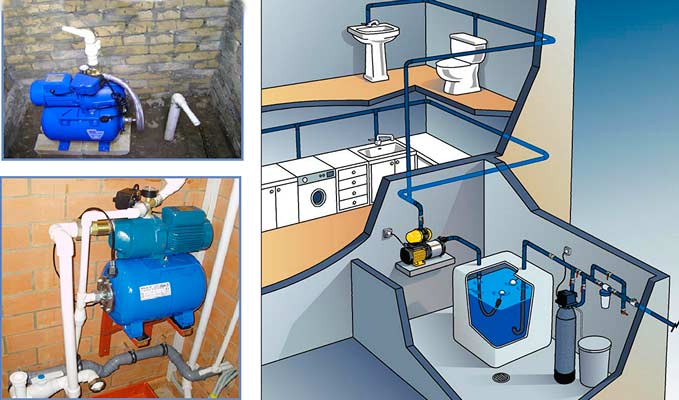
In order for water to be supplied to the water intake, various devices are used that perform the function of pumping (pumps), accumulation (storage tank), purification (filter), and then supplying good quality water resources to consumers.
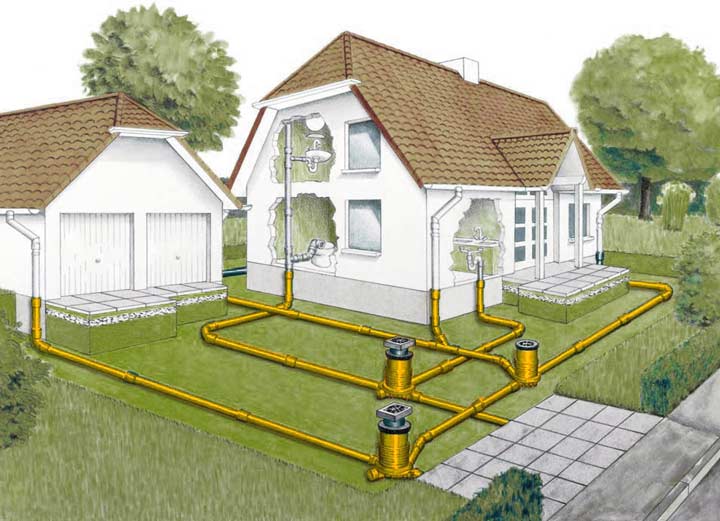
These systems, which provide the supply and discharge of fluid, are interconnected and their joint work contributes to the complete provision of comfortable living conditions in the household.

The principle of the waste system
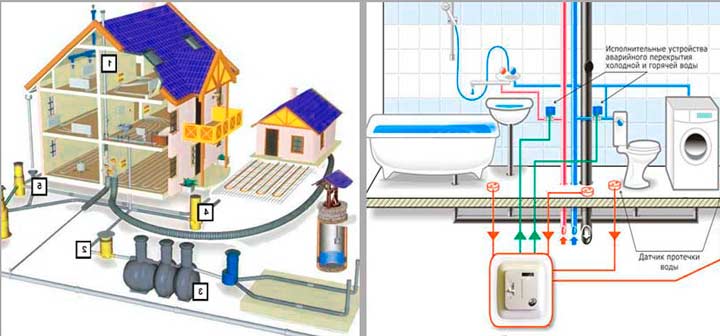
These communications are on the same level with the plumbing system and are the main part of comfortable living conditions, but only if they are properly arranged, namely, the absence of smell, dampness, blockages, etc.
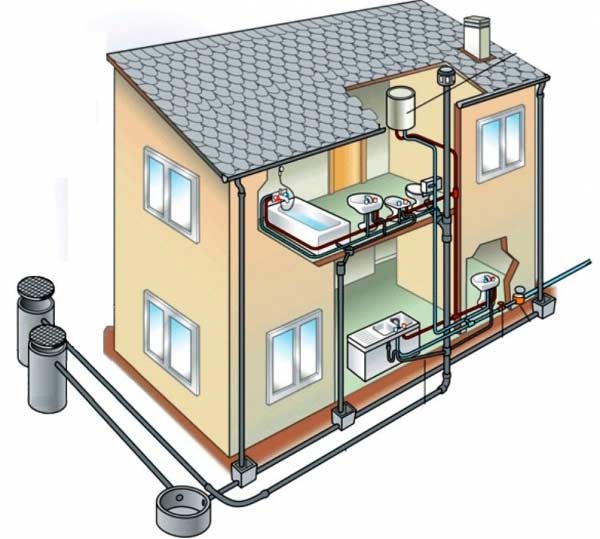
Moreover, the top of the riser has an outlet in the roof for ventilation. It turns out that the sewage system from the apartments is led to a common riser, from which it moves by gravity to a common sewer line.
They include principles that need to be considered when arranging. Just like in the sewer network.
Depending on the availability of pressure, such water supply systems differ
1. Operating under pressure in the external water supply.
They are used in the case when the guaranteed pressure in the water supply at the point of direct connection of the input is greater than the pressure required for the normal operation of water folding devices, or equal to it. Such systems are the simplest, most common.
2. With the presence of a water tank without a pumping unit.
They are used when the guaranteed pressure in the water supply during the highest water consumption becomes lower than required for the building, at other hours of the day - higher than necessary. During insufficient pressure, consumers are provided with water from a water tank, which accumulates it in case of excessive pressure.
3. With a booster pumping unit without a water tank.
It is used for uniform water consumption in the building, constant or periodic pressure in the external water supply system is lower than required for a particular building.
4. With water tank, booster pump.
It is used when there is a shortage of guaranteed pressure in the water supply system and in case of uneven water consumption in the building throughout the day. The water tank, which receives excess water or makes up for its deficiency during the direct operation of the network, is included in the system as a control tank to increase the efficiency of the pumping unit. When a tank exists, the pumps are usually automated.
Sometimes, instead of a water tank, a pneumatic installation is used, consisting of a water and air tanks or one air tank, which are equipped with special equipment (pressure gauges, compressors, valves, etc.). Such a water supply system is called a system with booster pumps, as well as a pneumatic installation.
Zone water supply systems are designed in high-rise buildings. So, the lower zone will work under the pressure of the water supply, the upper one - from the pumps. The height of the zone is determined by the most allowable hydrostatic head at the lowest point of the network.
For an individual residential building, the following groups of water supply schemes are provided:
- water supply with direct connection to a centralized water system;
- creation of a local water supply system.
Of course, the first version is simpler, more reliable, but there is a small hitch: a centralized water supply system with all the attributes (treatment facilities, pumping station, etc.) is not often found near a country house. But if you are lucky, then you should consider this case.
But you need to pay attention to one such important detail: the main condition under which water supply can be installed in a country house is the possibility for discharge and disinfection of wastewater. Thus, water supply and sewerage cannot be separated.
Drainage systems and their types
When taking water from a particular source, you need to remember that after use it must be diverted. Currently, three types of water disposal are known:
- organized sewer network;
- private/local treatment facilities with effluent discharge into soil or water;
- storage tanks cleaned with sewage trucks.
When arranging several cottages at the same time, as a rule, local treatment facilities are organized, located on a separate site, where discharge is made. As a rule, biological deep cleaning stations based on activated sludge are used for cleaning.
Activated sludge acts as an oxidizing agent for organic compounds. Deep cleaning includes the removal of suspended matter from wastewater, the oxidation of organic matter, and the neutralization of nitrogen and phosphorus. When the water is discharged, disinfection is carried out. The maximum volume of water treated by the station is its main characteristic. Usually 1 cottage gives 1-1.5 m³ of wastewater.
The movement of wastewater to the treatment complex is provided by a sewer network, consisting of two parts: intra-quarter and local, located directly next to the house.
When building a sewer, it is advisable to initially plan it so that it is gravity-flowing throughout its entire length. Turns, junctions and control points are equipped with wells for easy access. If it is impossible to form a gravity network, a pressure branch is designed, equipped with a well with a pump that pumps wastewater.
Water is transferred to the sewer well through a pressure branch. In order to organize the drainage from each house of the complex, as a rule, small pumping stations are installed. They are mounted in the basement or in a well located near the house.
Summing up, we can say that water supply and sewerage are utilities, without which a comfortable life in a country house is simply impossible. Wastewater is an indispensable system for ensuring compliance with sanitary standards in any settlement
It doesn’t matter if you live in an apartment or a private house, it is impossible to ensure cleanliness without drainage
Articles about the arrangement of water supply and sewerage
How to connect the dishwasher to the water supply and sewerage?
The automatic dishwasher for washing dishes is gradually turning from an expensive excess in the kitchen into household appliances of constant use. At the same time, to connect a dishwasher (PMM) to the necessary communications, you do not need to have special knowledge and skills ...
How to connect a toilet to a sewer pipe?
If, after repairs in the toilet, there is no desire to get a fetid flood at some point, then the connection of the toilet bowl to the sewer should be approached with all attention. This plumbing has three different drain outlet options, which somewhat complicates its installation.
One…
How to make plumbing in a country house?
It is difficult to call a cottage in which there is no water supply modern and comfortable for living. Walking with a bucket to a well or a column is something from fairy tales or old grandmother's stories today. Plumbing in a private house must be mandatory. And sde…
What are plumbing pipes?
There is a huge range of pipes for water supply on the market. They differ in diameter, technical characteristics, price and material of manufacture. To make the best choice, you need to carefully study the pros and cons of each option. It is from tr…
Do-it-yourself sewer installation in a private house
It is not always possible to connect a country cottage to the village sewer system. But now there are various septic tanks for installation within your own estate. You can always put one of the options with your own hands and connect pipes from home to it ...
Plastic pipes for plumbing
Behind the designation "plastic pipes" lies a huge range of pipe products made of various types of plastics and with different characteristics and sizes. Choosing the right option for the plumbing system in a cottage or apartment is often incredibly ...
Connecting a water heater (boiler) to the water supply with your own hands
The lack of centralized hot water supply or its constant shutdowns force the owners of cottages and apartments to install water heaters at home. Often this is an electric or gas equipment of a boiler (accumulative) type. Etc…
Connecting the drain of the washing machine to the sewer
Installing a washing machine in the house includes connecting it not only to the mains and water supply, but also to the sewer system. Moreover, it is with the drain that difficulties often arise, to connect the household appliances in question to the power supply and water ...
Proper wiring of sewer pipes in a private house
Without a working sewer system, a country cottage instantly turns from a comfortable dwelling into a slum shack. But in order for the drain in the sink and toilet to function correctly and without breakdowns, the sewer wiring in a private house must be done ...
Pipes for internal sewerage
If you want to get an uninterrupted and problem-free sewer system, then the choice of components for it should be given maximum attention. According to the material for making sewer pipes, plastic, asbestos-cement, steel and ceramic are now used ...
Polypropylene pipes for plumbing
Plastic products are now ubiquitous. And engineering communications are no exception. Plastic is cheap and durable, but you should choose polypropylene pipes for plumbing in your home wisely. Any rupture of the internal water supply pipeline is ...
